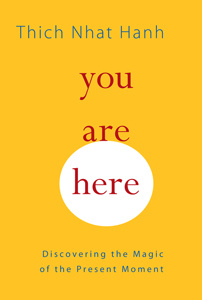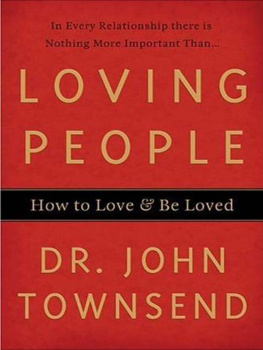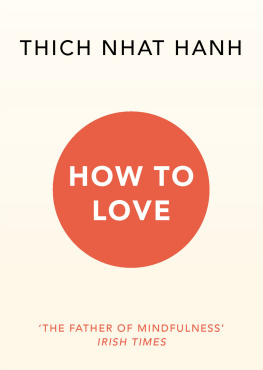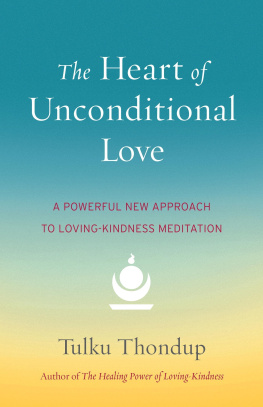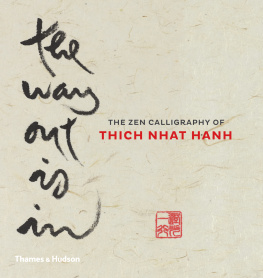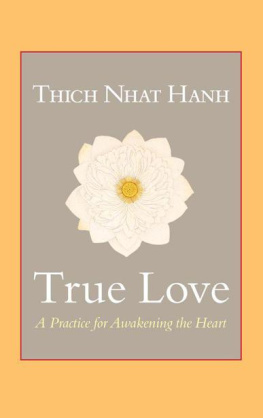Among Buddhist leaders influential in the West, Thich Nhat Hanh ranks second only to the Dalai Lama.
New York Times
A simplicity and directness that brings true love within reach.
Dragonfly Review
Recommended reading for anyone who loves.
Ascent Magazine
Thich Nhat Hanh writes with the voice of the Buddha.
Sogyal Rinpoche, author of The Tibetan Book of Living and Dying
[Thich Nhat Hanh] shows us the connection between personal, inner peace and peace on earth.
the Dalai Lama
ABOUT THE BOOK
Love might not be what we think it is. We all seek the happiness that comes from loving and being loved, yet we often find ourselves dissatisfied in our relationships and unable to grasp the cause. Thich Nhat Hanh here shows the way to overcome our recurrent obstacles to loveby learning to be mindful, open, and present with ourselves and others. As he explains, training is needed in order to love properly; and to be able to give happiness and joy, you must practice deep looking directed toward the person you love. Because if you do not understand this person, you cannot love properly. Understanding is the essence of love.
This quintessential guide to loving also introduces the four key aspects of love described in the Buddhist traditionloving-kindness, compassion, joy, and freedomand describes many simple and direct ways in which we can practice authentic love in our everyday lives.
A Vietnamese Zen Buddhist monk, THICH NHAT HANH is an internationally known author, poet, scholar, and peace activist, and was nominated for the Nobel Peace Prize by Martin Luther King Jr. He is the author of numerous books, including the best-selling Living Buddha, Living Christ; Anger: Wisdom for Cooling the Flames; Peace Is Every Step; and The Miracle of Mindfulness. He is the leader of monastic communities in New York, California, France, Germany, Hong Kong, and Vietnam, and his teachings inspire several hundred local groups of lay practitioners across the United States, Latin America, Europe, Africa, Asia, and Oceania.
Sign up to learn more about our books and receive special offers from Shambhala Publications.

Or visit us online to sign up at shambhala.com/eshambhala.
TRUE LOVE
A Practice for Awakening the Heart
THICH NHAT HANH
Translated by
Sherab Chdzin Kohn
SHAMBHALA Boston &London 2011 |  |
SHAMBHALA PUBLICATIONS, INC.
Horticultural Hall
Shambhala Publications
300 Massachusetts Avenue
Boston, Massachusetts 02115
www.shambhala.com
1997 by Unified Buddhist Church, Inc.
Originally published in French under the title Vivre en Pleine Conscience
Published by arrangement with the Unified Buddhist Church, Inc., 2496 Melru Lane, Escondido, CA 92026 USA.
Translation 2004 by Shambhala Publications
All rights reserved. No part of this book may be reproduced in any form or by any means, electronic or mechanical, including photocopying, recording, or by any information storage and retrieval system, without permission in writing from the publisher.
LIBRARY OF CONGRESS CATALOGING-IN-PUBLICATION DATA
Nht Hnh, Thch.
[Vivre en Pleine Conscience. English]
True love : a practice for awakening the heart / Thich Nhat Hanh;
translated by Sherab Chdzin Kohn.1st Shambhala ed.
p. cm.
In English; translated from French.
Originally published: Vivre en Pleine Conscience. Editions Terre du Ciel, 1997.
eISBN 978-0-8348-2107-1
ISBN 1-59030-188-9
1. LoveReligious aspectsBuddhism. 2. CompassionReligious aspectsBuddhism. 3. BuddhismDoctrines. I. Chdzin, Sherab.
II. Title.
BQ5359.N53 2004
294.35677dc22
2004006987
A CCORDING TO BUDDHISM, THERE ARE four elements of true love.
The first is maitri, which can be translated as loving-kindness or benevolence. Loving-kindness is not only the desire to make someone happy, to bring joy to a beloved person; it is the ability to bring joy and happiness to the person you love, because even if your intention is to love this person, your love might make him or her suffer.
Training is needed in order to love properly; and to be able to give happiness and joy, you must practice deep looking directed toward the person you love. Because if you do not understand this person, you cannot love properly. Understanding is the essence of love. If you cannot understand, you cannot love. That is the message of the Buddha. If a husband, for example, does not understand his wifes deepest troubles, her deepest aspirations, if he does not understand her suffering, he will not be able to love her in the right way. Without understanding, love is an impossible thing.
What must we do in order to understand a person? We must have time; we must practice looking deeply into this person. We must be there, attentive; we must observe, we must look deeply. And the fruit of this looking deeply is called understanding. Love is a true thing if it is made up of a substance called understanding.
The second element of true love is compassion, karuna. This is not only the desire to ease the pain of another person, but the ability to do so. You must practice deep looking in order to gain a good understanding of the nature of the suffering of this person, in order to be able to help him or her to change. Knowledge and understanding are always at the root of the practice. The practice of understanding is the practice of meditation. To meditate is to look deeply into the heart of things.
The third element of true love is joy, mudita. If there is no joy in love, it is not true love. If you are suffering all the time, if you cry all the time, and if you make the person you love cry, this is not really loveit is even the opposite. If there is no joy in your love, you can be sure that it is not true love.
The fourth element is upeksha, equanimity or freedom. In true love, you attain freedom. When you love, you bring freedom to the person you love. If the opposite is true, it is not true love. You must love in such a way that the person you love feels free, not only outside but also inside. Dear one, do you have enough space in your heart and all around you? This is an intelligent question for testing out whether your love is something real.
T O LOVE, IN THE CONTEXT OF BUDDHISM, IS above all to be there. But being there is not an easy thing. Some training is necessary, some practice. If you are not there, how can you love? Being there is very much an art, the art of meditation, because meditating is bringing your true presence to the here and now. The question that arises is: Do you have time to love?
I know a boy of twelve whose father asked him one day: Son, what would you like for your birthday present? The boy did not know how to answer his father, who was a very rich man, able to buy anything for his son. But the boy did not want anything except his fathers presence. Because the role the father played kept him very busy, he did not have time to devote to his wife and children. Being rich is an obstacle to loving. When you are rich, you want to continue to be rich, and so you end up devoting all your time, all your energy in your daily life, to staying rich. If this father were to understand what true love is, he would do whatever is necessary to find time for his son and his wife.
The most precious gift you can give to the one you love is your true presence. What must we do to really be there? Those who have practiced Buddhist meditation know that meditating is above all being present: to yourself, to those you love, to life.
Next page
